Types of Large Grasshoppers (Including Giant Grasshoppers) – Pictures and Identification
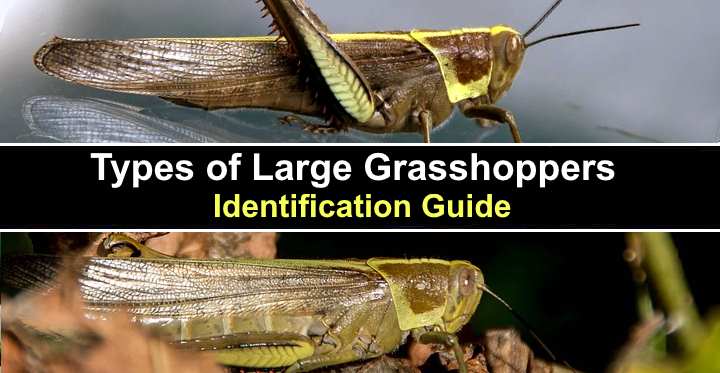
Large grasshoppers are gigantic insects measuring between 2 and 3 inches (50 to 75 mm). The giant, winged creatures are typically a green or brown color and have six legs and two antennae. Species of large grasshoppers are found throughout North America, with the largest species being lubber grasshoppers. But are these the largest grasshoppers in the world? Please read the article to find out.
Grasshoppers are some of the most ancient herbivorous insects in the world, and some species are native to the United States. Large grasshoppers are generally flying insects. However, some prefer to use their characteristic large hind legs for leaping. Additionally, many species of large grasshoppers can also be destructive pests as they gorge on vegetation and plant leaves. This is especially true of locusts—large grasshoppers that decimate crops.
This article is a guide for identifying the largest grasshoppers you will come across. Pictures of the six-legged insects with descriptions of their behavior, habitat, and appearance will help you recognize one of these huge insects.
The Largest Grasshopper in the World
The world’s largest grasshopper is the hedge grasshopper (Valanga irregularis), measuring around 3” (75 mm) long. However, some reports say the giant grasshopper can grow to 3.5” (90 mm). This gigantic grasshopper is native to Australia and has a brownish or tan-colored body. However, there are variations in appearance.
The eastern lubber grasshopper is the largest grasshopper in the United States, measuring just under 3” (80 mm). Apart from being a large native grasshopper, the unique insect also has distinctive red, yellow, and green coloration, making it easy to identify in gardens and grasslands.
The black western lubber grasshopper is slightly smaller, measuring 2.75” (70 mm).
How to Identify Large Grasshoppers
You can identify large grasshoppers by the distinctive shape of their robust hind legs when at rest. Grasshoppers have a long, slender body consisting of a head at a vertical angle to its body, thorax, and abdomen. You can tell grasshopper species apart by patterns or markings on their wings and body.
When identifying grasshoppers, it’s vital to remember that there can be wide color variations in individual species. For example, the large western horse lubber grasshopper in northern states is shiny black with yellow patterns on the wings. However, they are yellow grasshoppers in the south. Additionally, female grasshoppers are larger than their male counterparts.
You can also identify grasshoppers by the ticking or clicking noises they make. Although humans can’t tell species apart from these grasshopper “songs,” individual species have unique noise patterns.
Grasshoppers are generally easy to distinguish from other insects in the garden. However, there are some grasshopper lookalikes, such as crickets and katydids. Some species of cricket and katydids have similar ‘V’-shaped hind legs and wing shapes similar to most grasshoppers.
Types of Giant Grasshoppers
Species of grasshoppers are winged insects with amazing jumping capabilities. They can be tiny insects measuring a few millimeters, or huge creatures several inches long. This article looks at 14 species of large grasshoppers, starting with the largest one in the world—the hedge grasshopper.
Hedge Grasshopper (Valanga irregularis)
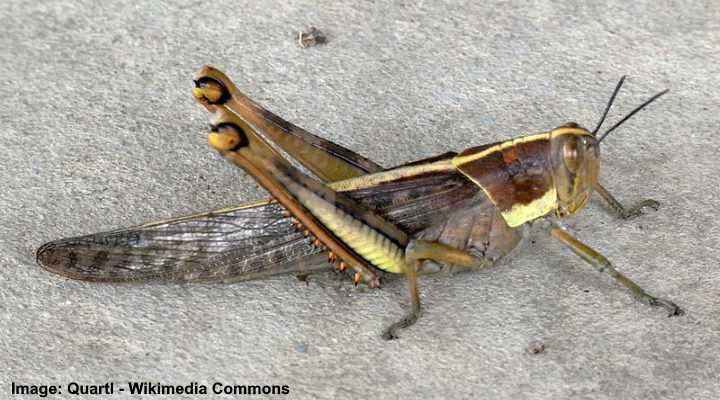
The hedge grasshopper is the biggest grasshopper in the world and is also called the giant grasshopper
Also called the giant grasshopper, the hedge grasshopper is identified as one of the largest insects in the suborder Caelifera. The creamy-brown to dark brown insect measures 3” (75 mm) long, with the males smaller at 2.1” (55 mm). The huge grasshoppers are active in spring and fall in northern Australia.
The hedge grasshopper is typically identified by its dark brown, slightly mottled wings, brown thorax with yellow stripes, brown head, and short, straight antennae. The large insects also have orange pegs on the brown and yellow hindlegs. Some species of hedge grasshoppers are creamy-brown to grayish-green.
These gigantic grasshoppers have been known to grow up to 3.5” (90 mm). They feed on several species of oriental shrubs and palm trees. Although the insects feed on vegetation, they don’t cause enough damage to be considered pests. In addition, they are not a swarming species of grasshopper.
Chinese Grasshopper (Acrida cinerea)
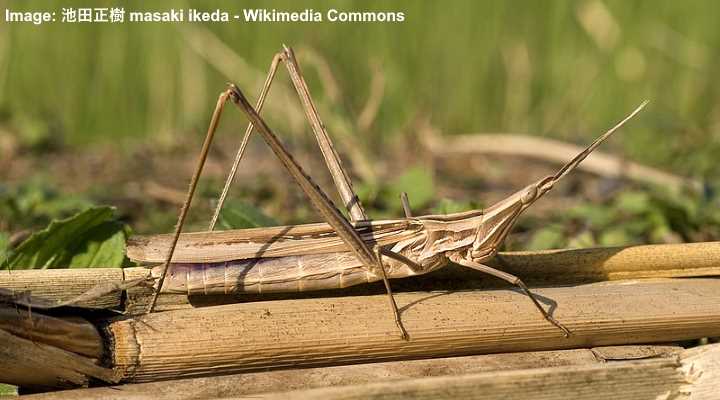
The Chinese grasshopper is a type of giant grasshopper which is identified by its long slender head
Another giant grasshopper species is the oriental long-headed grasshopper or Chinese grasshopper. These long, brown, large insects have an overall pale brown color with creamy-yellow and brown markings on the wings, thorax, and head. In addition, the brown grasshopper has a distinctive long, slender head, unlike typical grasshoppers.
The Chinese grasshopper is huge, measuring 2.8” to 3.1” (70 – 80 mm) long, and the males are 1.6” to 2.0” (40 – 50 mm). One of the distinguishing features of the enormous grasshopper is its long legs. The legs don’t look as robust as typical grasshoppers, but they enable the insect to jump great distances.
Like all grasshoppers in the genus Acrida, the Chinese grasshopper lacks the stridulatory organs on its legs that make clicking noises as it moves.
Eastern Lubber Grasshopper (Romalea microptera)

The colorful eastern lubber grasshopper is one of the largest grasshoppers in southeastern United States and can be a serious pest
The eastern lubber grasshopper is one of the enormous grasshoppers native to North America. Due to its colorful patterns, the native grasshopper is easy to identify. The giant grasshopper is characterized by bright orange, red, and black markings, orange legs, and small eyes. The grasshopper is active in Florida and throughout the southern, eastern, and central United States.
Eastern lubber grasshoppers grow 2.5” to 3” (64 – 71 mm) long. The pesky insect has a voracious appetite and feeds on many species of broadleaf plants. Although this is a winged insect, the wings are too small for flying. So, the lubber grasshopper gets around using its hindlegs as springs.
Also called the Florida lubber grasshopper, the insect looks different in the Sunshine State. In the south, the grasshopper is identified as a black grasshopper with yellow or red stripes. It is also called the black diablo, giant locust (although it doesn’t fly), devil’s horse, or graveyard grasshopper.
Related reading: How to get rid of grasshoppers.
Western Horse Lubber Grasshopper (Taeniopoda eques)
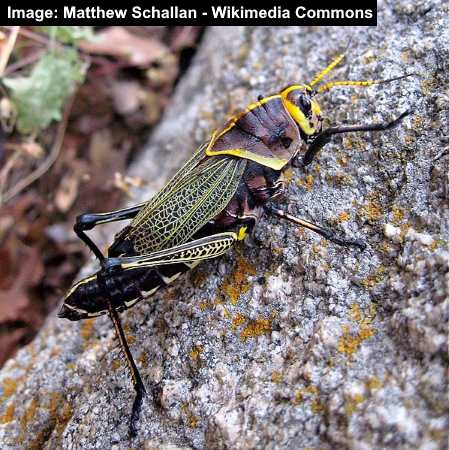
The western horse lubber grasshopper has colorful patterns and is one of the largest in US
The western horse lubber grasshopper is a huge native grasshopper in the United States. The eye-catching insects have an overall black color with finely veined wing markings. It’s an easily identifiable grasshopper with its dark brown thoracic region, yellow edges, yellow and brown head, and yellow antennae.
As one of the largest grasshoppers in the US, the western horse lubber measures 2.75” (70 mm), and the males are significantly smaller. The large females can weigh as much as 0.32 oz. (9 g), which is about the weight of a small mouse. Like the eastern lubber, this black grasshopper cannot fly.
Western horse lubbers are found in Texas, New Mexico, and southern Arizona. It feeds on low-growing summer annuals, including their leaves, flowers, and seed pods. These distinctive grasshoppers also consume small insects and invertebrates. In the south, some of these insects are yellow.
Gray Bird Grasshopper (Schistocerca nitens)
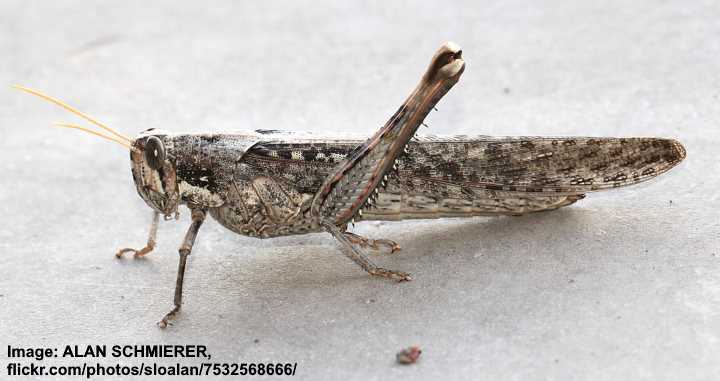
The large gray bird grasshopper is a garden pest and is native to southwest US
The gray bird grasshopper is a large species of short-horned grasshopper native to the southwestern US. This giant flying insect is a destructive pest, identified by its gray, black, and white mottled patterns. However, a distinctive feature is its pointed yellow antennae. Although related to the desert locust, this species doesn’t typically swarm.
The gray bird grasshopper grows 1.57” to 2.75” (40 to 70 mm) long, and the males up to 2” (50 mm). These large grasshoppers are a nuisance in gardens because they can destroy the vegetation of many ornamental and crop plants.
Also called the vagrant grasshopper, the annoying flying “bug” is found from California to Texas. This plant-eating insect also has become invasive in Hawaii, where heavy grasshopper infestations cause extensive damage to some islands.
Egyptian Grasshopper (Anacridium aegyptium)
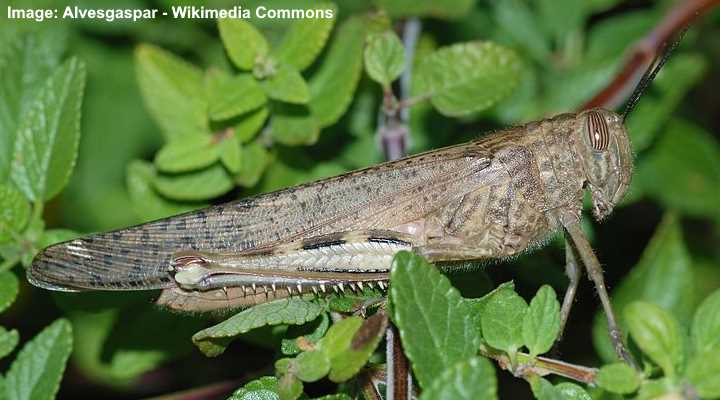
The Egyptian grasshopper is a type of a large grasshopper that can be found in USA
Also called the Egyptian locust, this invasive grasshopper is a grayish-brown or olive-colored large insect with blackish spots on its wings, abdomen, and thorax. In addition, this relatively large grasshopper has black bands and creamy white patches on its hind legs. Other identifiable features are its short, robust antennae and oval brown, striped eyes.
Growing up to 2.8” (70 mm), this gigantic grasshopper is classified as the largest species of European grasshopper. The females measure 1.8” to 2.8” (46 – 70 mm), and the males are 1.2” to 2.2” (30 – 56). The brown or olive-colored adults are active from late summer until September.
Although not native to North America, this huge European grasshopper species has been spotted in the western United States. The plant-destroying insects inhabit shrubs, trees, and scrubland.
Types of Large Grasshoppers
You can find many species of large grasshoppers measuring 1” to 2” (25 – 50 mm). Many of these sizable insects are commonly found in North America. Please read on to discover more about large brown and green grasshoppers.
Differential Grasshopper (Melanoplus differentialis)
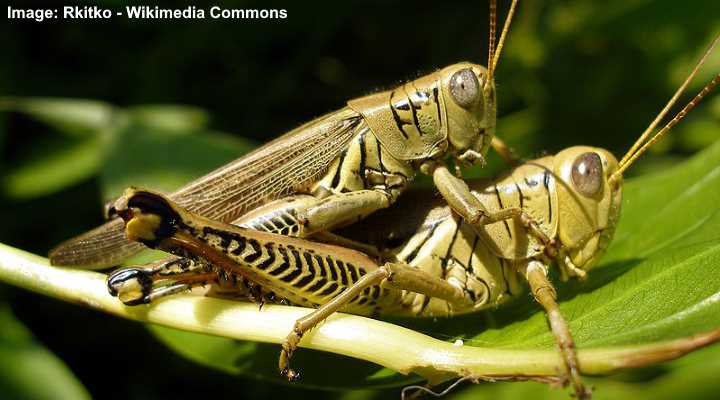
The yellowish-green differential grasshopper has black patterns on its hind legs and is quite big
The differential grasshopper is identified as a large insect species found throughout the US. The large grasshopper is characterized by a yellowish-green body with black stripes and black chevron marking on its hind legs. Additionally, the pale brown wings have yellow vein-like patterns. Immature differential grasshoppers are bright green.
Large female differential grasshoppers measure 1.33” to 2.0” (34 – 50 mm), and the males are slightly smaller measuring 1.1” to 1.4” (28 – 37 mm). Additional identifying features are its short antennae, spiny hind legs, and brownish or greenish coloration.
This destructive, annoying insect feeds on crops like cotton, corn, and deciduous fruit trees. And because the flying grasshoppers feed in swarms, they can do tremendous damage to large areas of farmland.
American Grasshopper (Schistocerca americana)
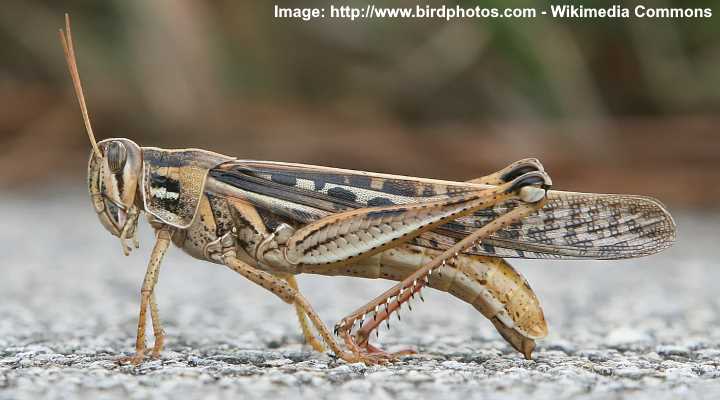
The large American grasshopper is identified by its intricate brown and beige patterns and spiny hind legs
Also called the American bird grasshopper, this insect is large and is a yellow-brown color. The large grasshopper has intricate dark brown and tan patterns on its wings and brown, tan, and white stripes on its thorax. Up close, you’ll notice black and white spines on its pale brown rear legs.
American grasshoppers are relatively large insects growing up to 2.2” (55 mm) long. The males are slightly smaller, with a body length of 1.8” (45 mm). The immature grasshopper can be red, yellow, or green with black spots. They become more yellowish-brown as they mature. Southern species are significantly darker.
The native habitat of the American grasshopper is east of the Great Plains to Florida. Unfortunately, the flying grasshopper significantly damages crops like corn, oats, peanuts, citrus trees, and sugarcane. They also have a habit of feeding in swarms when they can do much damage.
Spotted Bird Grasshopper (Schistocerca lineata)
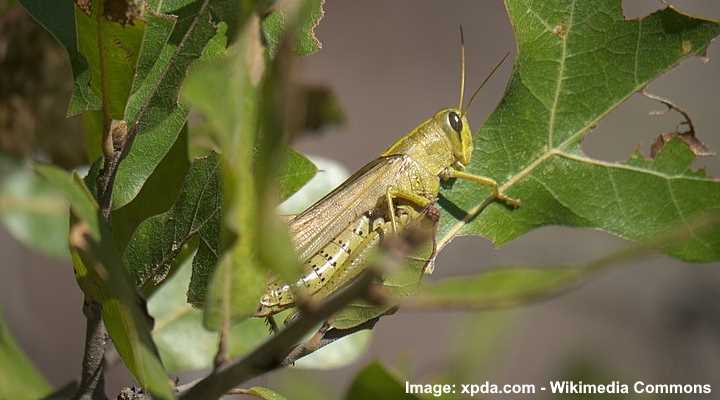
The spotted bird grasshopper is olive-green in color and is quite big
Also known as the birdwing grasshopper, this is a large yellowish-green or olive-green insect. Identifying features of the grasshopper are its dark reddish to black rear legs with prominent white spines, long wings, and longitudinal stripes on its eyes. In addition, most spotted bird grasshoppers have a yellowish line along their bodies.
Spotted bird grasshoppers grow 1.30” to 2.16” (33 – 55 mm), and the males are around 0.39” (10 mm) smaller. The grasshopper is common in well-vegetated areas, prairies, and open woodlands throughout North America. This plant-destroying pest prefers destroying herbaceous plants, including elm trees, cotton, and maize.
Two-Striped Grasshopper (Melanoplus bivittatus)
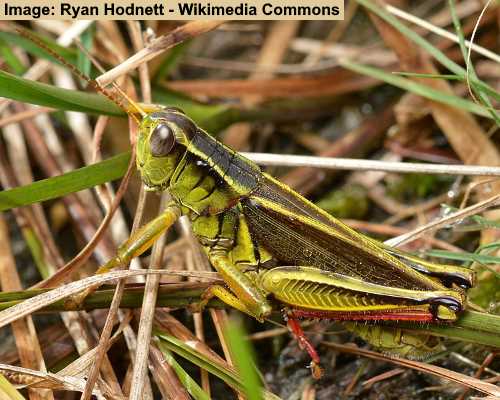
The large two-striped grasshopper feeds on crops and small insects
The two-striped grasshopper is classified as a large insect measuring over 2” (50 mm) long. As its name suggests, the identifiable feature of the grasshopper is two yellow stripes on its body. Additionally, the coloration of the grasshopper is typically yellowish-green and brown, and it has reddish-brown antennae with red lower hindlegs.
Also called the yellow-striped grasshopper, this large grasshopper measures 1.1” to 2.1” (30 – 55 mm). The grasshoppers eat a range of crops, especially lentils. However, they will also feed on other small insects and invertebrates and can turn cannibalistic if there is little food around.
Italian Locust (Calliptamus italicus)
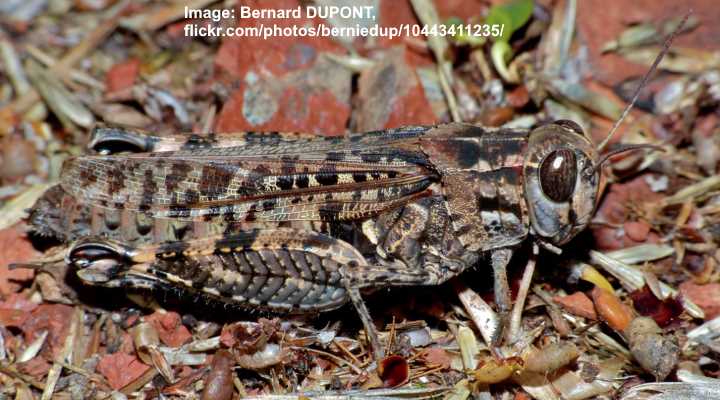
The relatively large Italian locust has brown and black mottled patterns that camouflage it well in nature
The Italian locust is a relatively large black and brown grasshopper. This species of short-horned grasshopper is distinguished by its mottled brown patterns peppered with black patches. This type of coloration gives the grasshopper excellent camouflage among leaves and debris on the ground. The grasshoppers are active from July through October.
Italian locusts grow up to 1.57” (40 mm) long. Although brownish-black patches are typical coloration, they can also be gray, reddish-brown, or pinkish-brown. The hungry grasshoppers feed on legumes, alfalfa, and wild plants. And, as their name locust suggests, they have a gregarious phase where they swarm as destructive locusts.
Large Marsh Grasshopper (Stethophyma grossum)
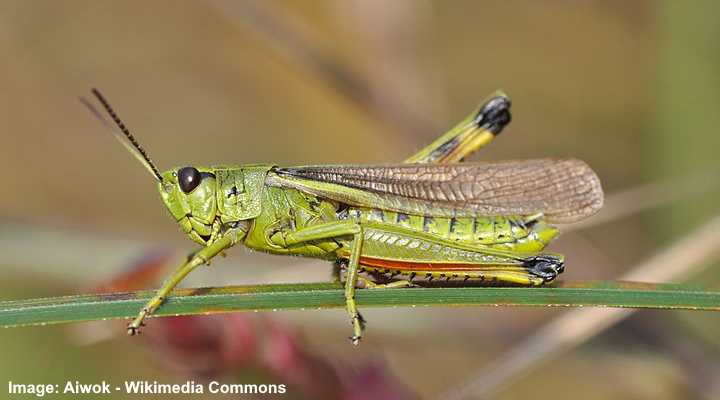
The large marsh grasshopper is one of the biggest in the UK and is mostly lime green with brown wings
The large marsh grasshopper is a large grasshopper — one of the largest in the United Kingdom. The lime-green insect has recognizable bands on its abdomen, green and yellow hind legs, dark brown to black antennae, and prominent black eyes. Additionally, the green grasshopper has brown wings. Unfortunately, the number of large marsh grasshoppers is decreasing.
Large marsh grasshoppers grow up to 1.5” (38 mm) long. The green insects tend to live near marshes, feeding on grasses and rushes. Although green and brown are their primary coloration, some vibrant pink species also occur.
Leather-Colored Bird grasshopper (Schistocerca alutacea)

The large leather-colored bird grasshopper has mostly green body with yellow antennae
The leather-colored bird grasshopper is a large grasshopper that is generally light green. Identifying features of the native grasshopper are its vertical face, yellow, brown, or black tibiae (lower part of the hindlegs), yellowish spots on its thorax, and slender yellow antennae.
Leather-colored bird grasshoppers measure up to 2.36” (60 mm) long. The large grasshoppers feed on legumes, oats, and ragweed. They tend to thrive where shrubs grow near water. Their native habitat is throughout the eastern United States, with a subspecies (Schistocerca alutacea shoshone) common from Texas to California.
Green-Striped Grasshopper (Chortophaga viridifasciata)
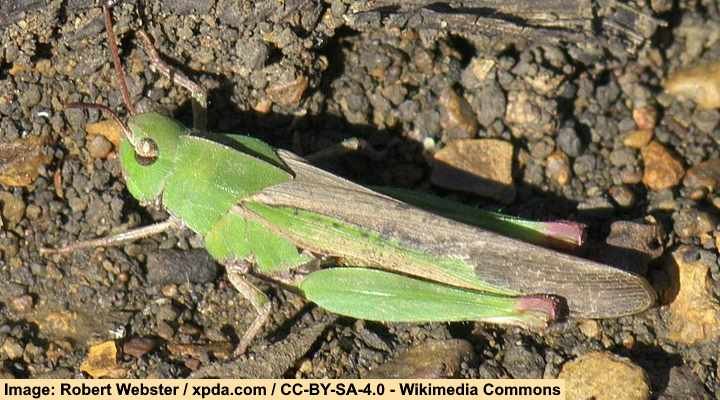
The green-striped grasshopper has a green and brown body and can be quite big
The green-striped grasshopper is a relatively large green insect with a black band on its wings. This species of band-winged grasshopper can also have pink coloration on its head, thorax, and hind legs. The large, green-striped grasshoppers are common throughout North America in pastures and sunny areas.
Green-striped grasshoppers grow between 1.1” and 1.50” (28 – 38 mm). Unlike most other grasshopper species, the males and females are the same sizes. However, the males tend to be brown, whereas the females are green. In addition, males have thicker legs and larger heads.
Related articles:
